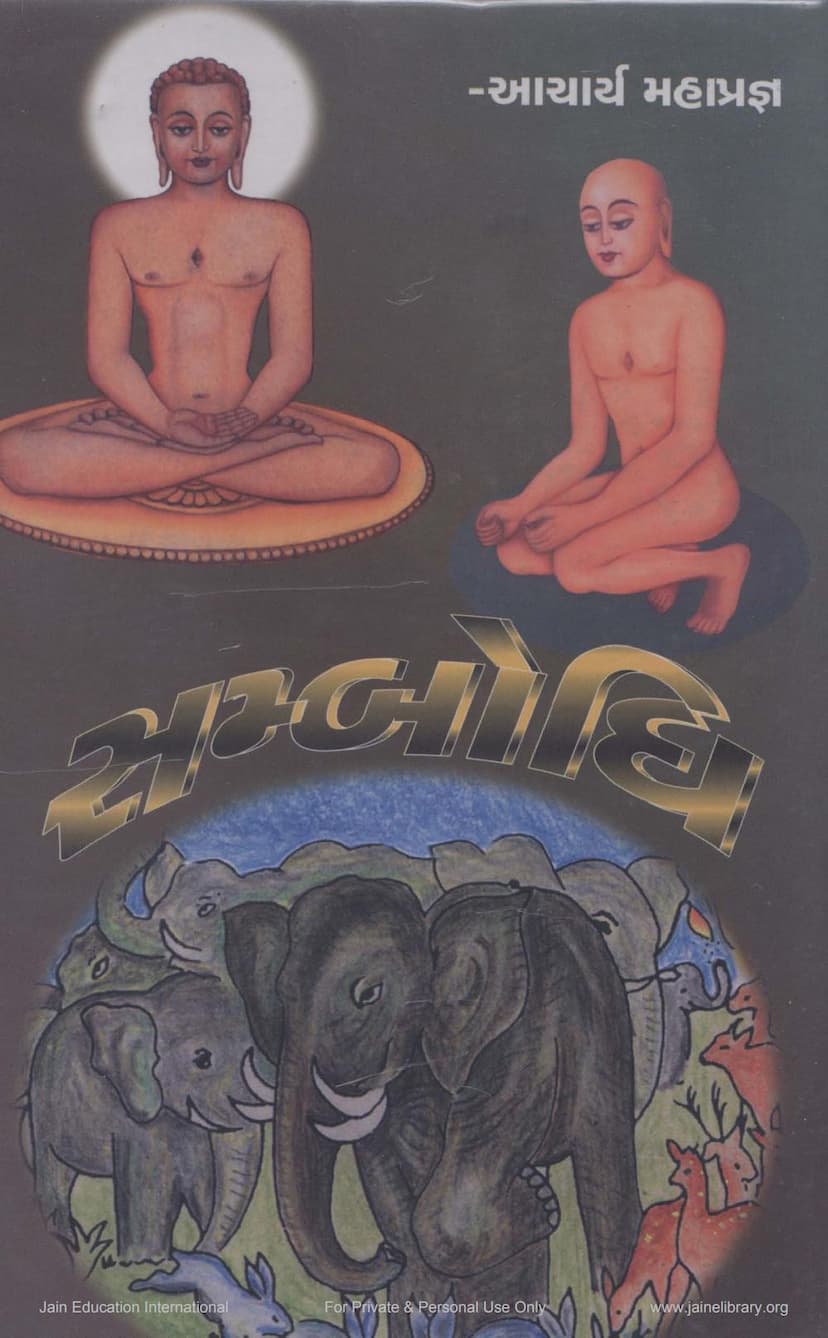Sambodhi
Added to library: September 2, 2025

Summary
Here is a comprehensive summary of the Jain text "Sambodhi" by Mahapragna Acharya, based on the provided pages:
Title: Sambodhi (સંબોધિ) Author: Acharya Mahapragna (આચાર્ય મહાપ્રજ્ઞ) Publisher: Anekant Bharati Prakashan (અનેકાન્ત ભારતી પ્રકાશન)
Core Theme: "Sambodhi" is presented as a guide for spiritual awakening and liberation, rooted in the teachings of Lord Mahavira. It emphasizes the path of self-mastery, overcoming delusion and ignorance, and attaining the pure, blissful state of the soul (Satchidananda). The text draws parallels with the Bhagavad Gita, highlighting the concept of self-surrender in Jainism as equivalent to divine surrender in other traditions, as the soul itself is considered the ultimate reality (Paramatma or Ishvara).
Narrative and Structure: The book's core narrative revolves around the story of Meghkumar, the son of King Shrenik and Queen Dharini. Meghkumar, despite a privileged upbringing and engagement to princess, experiences a profound spiritual calling after hearing Lord Mahavira's discourse. This leads him to seek initiation. The narrative then delves into Meghkumar's spiritual journey, particularly his initial struggles and doubts after becoming a monk. Lord Mahavira addresses these challenges by recounting Meghkumar's past lives, illustrating the concepts of karma, suffering, and the importance of perseverance through hardship.
Key Concepts and Teachings:
-
Sambodhi: The central concept, signifying spiritual awakening, true knowledge, and the ultimate realization of the soul. It is described as the path to self-liberation and complete self-reliance. The text asserts that Sambodhi is attained through the integration of right faith (Samyag Darshan), right knowledge (Samyag Gyan), and right conduct (Samyag Charitra).
-
The Story of Meghkumar:
- Birth and Upbringing: Meghkumar's birth follows Queen Dharini's dream of an elephant entering her mouth. He receives a comprehensive education in various arts.
- Spiritual Awakening: Hearing Lord Mahavira's sermon instills a sense of detachment and a desire for renunciation.
- Initial Struggles: After initiation, Meghkumar faces difficulties in monastic life, particularly discomfort and a feeling of being ostracized by fellow monks. This leads to him questioning his decision and considering returning home.
- Lord Mahavira's Intervention: Lord Mahavira, understanding Meghkumar's distress, recounts his past lives:
- Elephant (Sumēruprabha): As an elephant, he endured immense suffering and physical hardship, including being stuck in mud and later holding his leg up for days to protect a rabbit. He faced immense pain and eventual death with equanimity.
- Second Elephant Life: In another elephant life, he diligently protected his herd from a forest fire.
- Human Birth: These past austerities and steadfastness earned him a human birth as Meghkumar.
- Lesson Learned: By contrasting Meghkumar's current minor discomforts with the extreme sufferings of his past lives, Lord Mahavira instills in him the importance of perseverance, equanimity, and the understanding that true happiness comes from inner strength, not external comforts. Meghkumar's conviction is renewed.
- Spiritual Progress: Meghkumar dedicates himself to rigorous spiritual practice, observing the five great vows (Mahavratas), practicing meditation, and ultimately achieving spiritual purification.
- Ultimate Liberation: Meghkumar attains the state of a Kevalin (omniscient being) and eventually achieves liberation (Siddhi), residing in the Mahavimana for a long period before final liberation in Mahavideh.
-
The Nature of Happiness and Suffering: The text argues that true happiness lies not in the acquisition or enjoyment of material possessions but in their renunciation and the detachment from them. External pleasures are transient and lead to suffering. True, lasting happiness (Sahajananda) is found within the soul, accessible through introspection and spiritual practice.
-
Karma and its Role: The book extensively discusses the doctrine of karma, emphasizing that individuals are responsible for their actions and their consequences. Past karma influences present experiences, and present actions shape future lives. Understanding karma is crucial for detachment and liberation.
-
The Three Jewels (Ratnatraya): Right Faith (Samyag Darshan), Right Knowledge (Samyag Gyan), and Right Conduct (Samyag Charitra) are presented as the foundational elements for spiritual progress and liberation. The text stresses that these three must be integrated for true enlightenment.
-
The Importance of Conduct (Acharan): The book details various aspects of righteous conduct, including:
- Ahimsa (Non-violence): Emphasized as the highest principle, encompassing not only physical non-violence but also mental and verbal non-violence. It's discussed in its gross and subtle forms.
- Control of Indriyas and Manas: The need to discipline the senses and the mind through practices like meditation, detachment, and mindful living is highlighted.
- The Five Great Vows (Mahavratas): While not explicitly detailed in the summary, the adherence to these vows is implied in Meghkumar's journey.
- Monastic Discipline (Samyam): The text touches upon the discipline required for ascetics, including mindful movement, speech, eating, and sleeping.
- Layman's Duty (Gṛhastha Dharma): The book also outlines the principles of righteous living for householders, emphasizing detachment from possessions and mindful engagement in worldly duties.
-
The Concept of "Sambodhi" vs. "Bodhi": The text distinguishes between various types of "Bodhi" (knowledge/awakening) and emphasizes "Sambodhi" as the comprehensive and ultimate spiritual awakening that leads to liberation.
-
Critique of False Beliefs: The text implicitly criticizes wrong views, such as the belief that rituals alone bring liberation or that external actions without inner transformation are sufficient. It stresses the importance of inner purity and understanding the essence of Dharma.
Overall Message: "Sambodhi" serves as an inspirational and instructive text for spiritual seekers. It guides individuals on the path to self-realization by providing philosophical insights, practical guidance, and compelling narratives that illustrate the Jain principles of karma, non-violence, detachment, and the ultimate goal of liberation (Moksha). The story of Meghkumar exemplifies the transformative power of spiritual wisdom and the importance of overcoming personal doubts and hardships through faith and diligent practice.